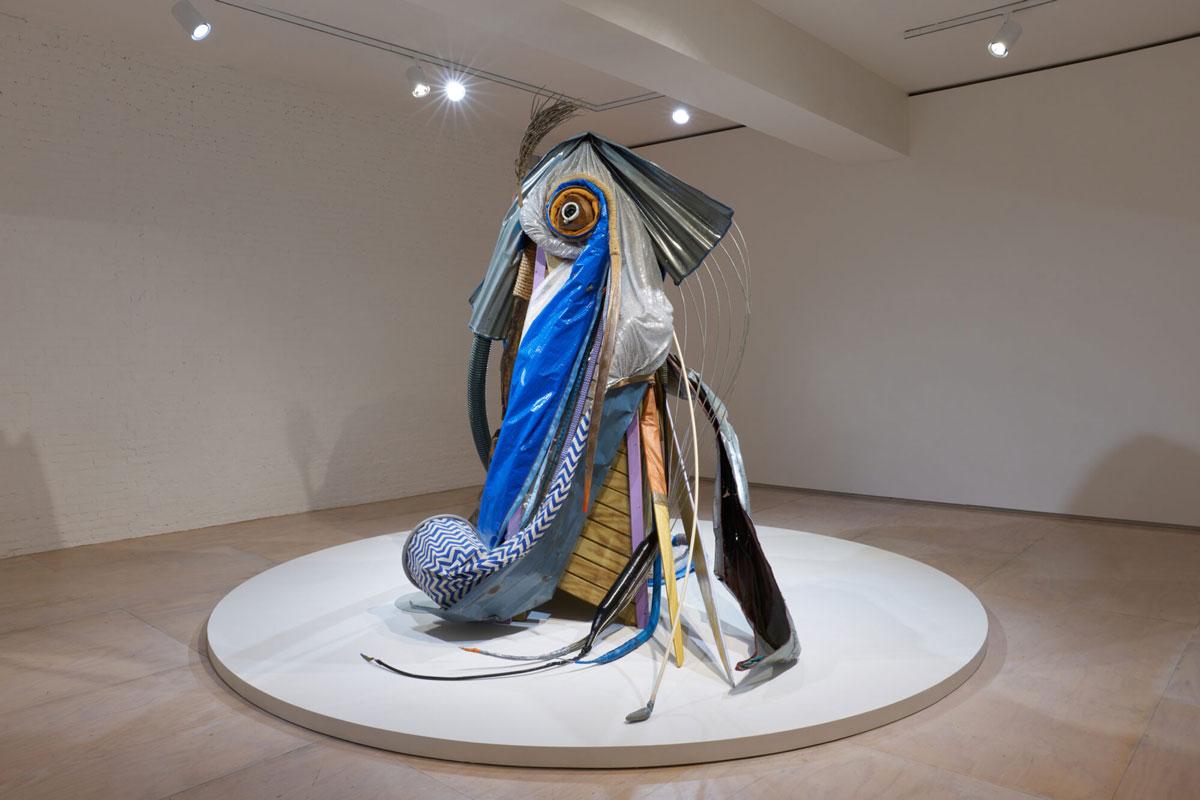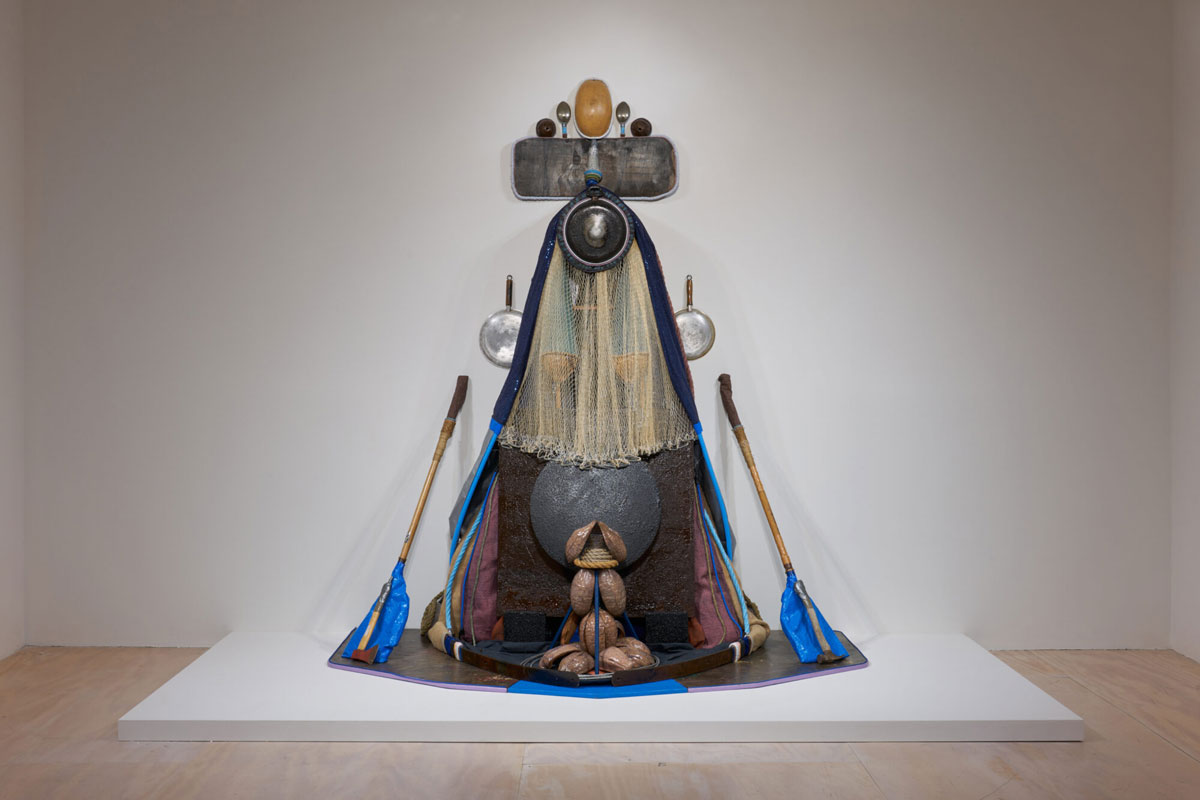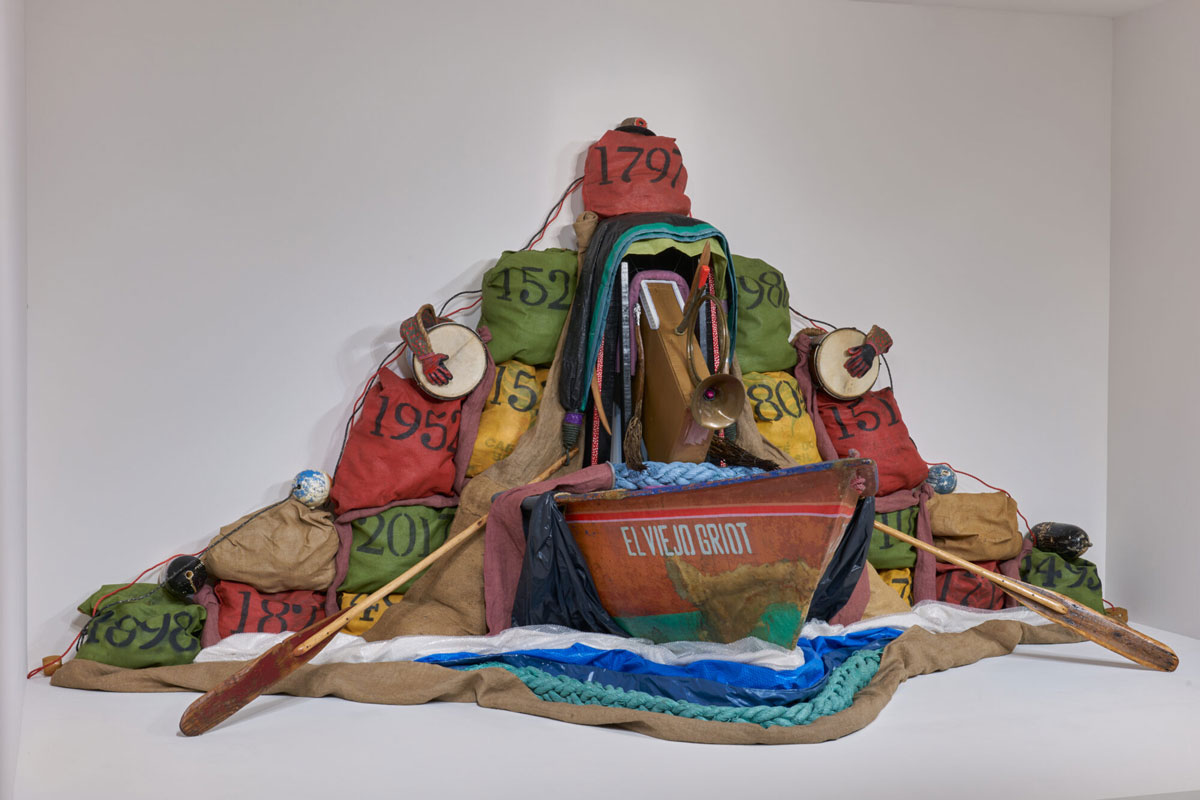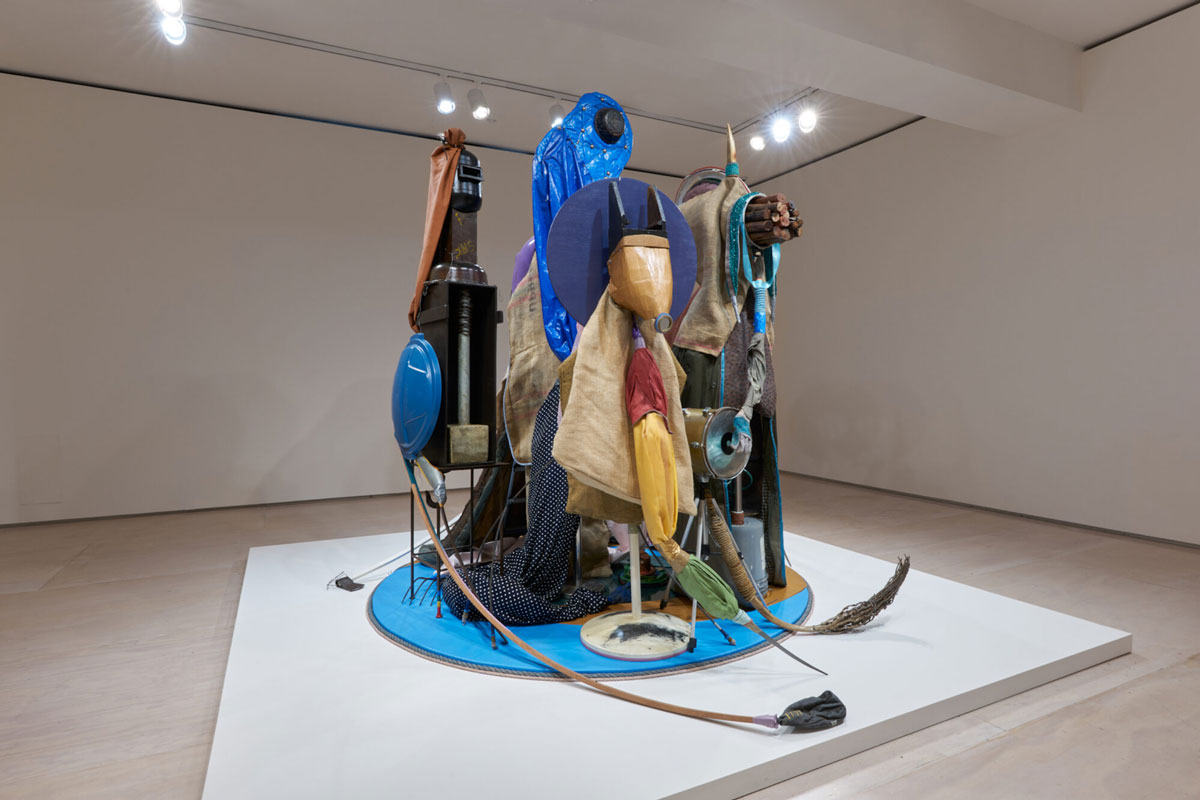PRESENTATION: Daniel LindRamos-El Viejo Griot,Una historia de todos nosotros
 Daniel Lind-Ramos uses found and gifted objects of personal, communal, and regional significance, such as everyday tools, objects of adornment, and debris salvaged from the beaches and streets near his studio, to create monumental sculptures and video works. His practice reflects the vibrant culture of the city Loíza by honoring local customs of agriculture, fishing, cooking, and masquerade through sculptures that evoke experiences of Hurricane Maria (2017), the COVID-19 pandemic, and ongoing environmental degradation.
Daniel Lind-Ramos uses found and gifted objects of personal, communal, and regional significance, such as everyday tools, objects of adornment, and debris salvaged from the beaches and streets near his studio, to create monumental sculptures and video works. His practice reflects the vibrant culture of the city Loíza by honoring local customs of agriculture, fishing, cooking, and masquerade through sculptures that evoke experiences of Hurricane Maria (2017), the COVID-19 pandemic, and ongoing environmental degradation.
By Dimitris Lempesis
Photo: MoMA Archive

Daniel Lind-Ramos. El Viejo Griot (The Elder Storyteller) (detail). 2022–2023. Photo: Steven Paneccasio
The exhibition “El Viejo Griot-Una historia de todos nosotros” showcases ten monumental sculptures and two video works that weave together Daniel Lind-Ramos’ multi-layered practice, including four new large-scale works created for the exhibition. The exhibition features works that honor fast-disappearing local customs of agriculture, fishing, cooking, and masquerade alongside landmark sculptures examine the repercussions of Hurricane Maria (2017), culminating with two large-scale works made within the last year that address the COVID-19 pandemic and its impact. Both created for the exhibition, “Centinelas de la luna nueva” (2022–23) and “El Viejo Griot” (2022–23) explore how Puerto Rican identity has been shaped by more than 500 years of colonialism, cultural erasure, and environmental destruction. “Centinelas de la luna nueva” references the harvest of mangroves in the beach community of Piñones, considering the mangrove’s cultural, spiritual, and ecological importance as a protector against erosion and the effects of climate change. “El Viejo Griot”, or “elder storyteller,” draws inspiration from a character in Loíza’s annual Fiestas de Santiago Apóstol to invoke critical events in Puerto Rico’s history. Additionally, two new works created during the COVID-19 pandemic, “Ambulancia” (2020) (2022–23) and “Alegoría de una obsession” (2022–23), incorporate objects like emergency lights and cleaning tools to explore collective experiences of trauma and loss. Also on view is Lind-Ramos’s complete series of three monumental works, “Las Tres Marías”, which draws on the contradictions between Maria as a revered saint and the devastation and loss of Hurricane Maria, which forever changed the ecosystem of the island. Combining materials the artist collected after the hurricane with items given to him by friends and neighbors, Lind-Ramos’s works embody features of the storm—such as wind and lightning—while also referencing how communities in Puerto Rico came together in its aftermath. Daniel introduced the series at the 2019 Whitney Biennial.. At first glance these found objects might look like miscellaneous elements that are part of a sculpture, they’re meant to bring a physical presence to a lot of the experiences and memories that the majority of us didn’t live through with the devastation of Hurricane Maria. They beautifully make something immaterial, like a memory, real in a space that we can reflect on now. Daniel, who had been mulling over these two specific works since 2018, jumped at the idea. In turn, each assemblage is constructed from different found objects and focuses on a different era of Puerto Rico — from the island’s indigenous roots and history of colonialism to its position in the modern world. “Bano de Maria” or the Bath of Mary is a relief that features the first object Daniel collected in the hurricane’s wake (a boat propeller, floating alongside him in the flood waters of Loiza_ at its top and a water basin at the foot of the assemblage. “The water was almost above my chest when I found it,” says Daniel. The assemblage focuses on water — not just on the ocean’s torrential flooding, but also water as a pathway of changing existences. Just like the majority of hurricanes that hit Puerto Rico, the majority of slaves that came to the island also came from West Africa.
Photo: Daniel Lind-Ramos, Baño de María (Bain-marie/The Cleansing), 2018-2022, Wood, palm tree branches and trunks, lacquered coconuts, FEMA tarp, various textiles, tambourines, metal buckets, wooden chair, trumpets, hammers, metal cables, metal fan, plastic tubing, plastic hoses, metal wire, nails, pins, rope, 127 × 120 × 48″ (322.6 × 304.8 × 121.9 cm), Courtesy the artist and The Ranch, Montauk
Info: Curators: Kate Fowle and Ruba Katrib, Assistant Curator, Elena Ketelsen González, MoMA PS1, 22-25 Jackson Avenue, Queens, NY, USA, Duration: 20/4-4/9/2023, Days & Hours: Mon, Thu-Fri & Sun 12:00-18:00, Sat 12:00-29:00, www.momaps1.org/
![Daniel Lind-Ramos, Figura emisaria (The Emissary) [detail], 2020, Steel, palm tree branches, dried coconuts, branches, palm tree trunks, wood panels, burlap, concrete blocks, glass, aluminum, fabric, and lights 108 × 60 × 47" (274.3 × 152.4 × 119.4 cm), Santa Barbara Museum of Art. Museum purchase with funds provided by the Luria/Budgor Family Foundation](http://www.dreamideamachine.com/web/wp-content/uploads/2023/05/Daniel_Lind_Ramos_03-2000x1334-1.jpg)



![Daniel Lind-Ramos, Ambulancia (2020) [Ambulance (2020)], 2022-2023, Wood armature, car bumpers, loudspeaker, emergency siren light, mattress bed spring, wheelbarrow, shovel, car brake lights, metal chairs, wood bed legs, car radiator, acrylic sheeting, lacquered tree bark, clothing, metal mesh, plastic textiles, burlap cloth, bedsheet, metal fasteners, flexible PVC tubing, metal clips, plastic tubing, shoes, rope, and wire, 100 × 132 × 48" (254 × 335.3 × 121.9 cm), Courtesy the artist and The Ranch, Montauk](http://www.dreamideamachine.com/web/wp-content/uploads/2023/05/Daniel_Lind_Ramos_13-2000x1334-1.jpg)
![Daniel Lind-Ramos, Ambulancia (2020) [Ambulance (2020)], 2022-2023, Wood armature, car bumpers, loudspeaker, emergency siren light, mattress bed spring, wheelbarrow, shovel, car brake lights, metal chairs, wood bed legs, car radiator, acrylic sheeting, lacquered tree bark, clothing, metal mesh, plastic textiles, burlap cloth, bedsheet, metal fasteners, flexible PVC tubing, metal clips, plastic tubing, shoes, rope, and wire, 100 × 132 × 48" (254 × 335.3 × 121.9 cm), Courtesy the artist and The Ranch, Montauk](http://www.dreamideamachine.com/web/wp-content/uploads/2023/05/Daniel_Lind_Ramos_15-2000x1334-1.jpg)
![Daniel Lind-Ramos, Ambulancia (2020) [Ambulance (2020)], 2022-2023, Wood armature, car bumpers, loudspeaker, emergency siren light, mattress bed spring, wheelbarrow, shovel, car brake lights, metal chairs, wood bed legs, car radiator, acrylic sheeting, lacquered tree bark, clothing, metal mesh, plastic textiles, burlap cloth, bedsheet, metal fasteners, flexible PVC tubing, metal clips, plastic tubing, shoes, rope, and wire, 100 × 132 × 48" (254 × 335.3 × 121.9 cm), Courtesy the artist and The Ranch, Montauk](http://www.dreamideamachine.com/web/wp-content/uploads/2023/05/Daniel_Lind_Ramos_16-2000x1334-1.jpg)

